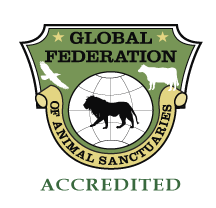ARCAS Wildlife Rescue Center in Peten
One of the natural resources under the greatest threat in Peten is its wildlife, a victim of habitat loss, unsustainable hunting and capture for the illegal pet trade. The decline in local populations of wild animals is obvious and dramatic. The large noisy flocks of scarlet macaws (Ara macao) reported by early explorers have been reduced to just 300 birds primarily in the Laguna del Tigre Park.
While fairly plentiful even 15 years ago, Baird’s tapirs and jaguars are becoming more and more difficult to see. The giant anteater and the Harpy eagle have not been sighted in recent years and are presumed extinct in the region.
Our ProgramsEnvironmental Education
ARCAS Wild Animal Rescue and Rehabilitation Center

The ARCAS Wildlife Rescue Center is accredited by the Global Federation of Animal Sanctuaries as having met the highest standard in humane animal care.
The Rescue Center is situated on a 45 hectare tract of land on Lake Petén Itza next to the Peténcito Zoo, just a 10 minute boat ride from the tourist center of Flores. It is comprised of a quarantine area, a veterinary clinic, animal maintenance area, pre-rehabilitation and Rehabilitation. There is a kitchen, dining room, workshop area, volunteer house, employee housing and a large floating dock. Large rehabilitation enclosures and flight cages are scattered throughout the jungle in order to reduce stress to the animals.
Animals received at the Rescue Center must first go through a quarantine period of at least 60 days in order to make sure that they do not have any diseases that can spread to the main rehabilitation population. Most animals received at the Center are very young and require immediate and constant care: chicks must be fed by hand; monkeys must be intensively supervised. When injured animals are received, they are taken immediately for medical treatment at the clinic.
Once animals finish quarantine, depending on the species, they are either formed into flocks or troupes and are released into the rehabilitation enclosures where they build up their flight muscles, improve their ability to move about in the forest and feed themselves. At this stage, they are analyzed in terms of their ability to survive in the wild.
"The ARCAS Wildlife Rescue Center is accredited by the Global Federation of Animal Sanctuaries as having met the highest standard in humane animal care".
The science of rehabilitation and re-introduction of wildlife is a new one, and is more complex than it first appears. It is not simply a question of opening the door of the cage and letting the animal out. Several factors come into play:
- First, animals must have the skills to be able to survive in the wild. Baby jaguars, for example, spend the first 18 months of their life with their mothers learning to hunt and avoid dangers.
- Second, animals – especially birds – must not become imprinted on humans because once they are released they will simply fly back to the nearest human and either be caught or killed.
- Third, and perhaps most important, released animals must be healthy and not introduce infectious diseases into wild populations.
Several times per year, ARCAS together with its government counterpart the National Council of Protected Areas (CONAP) conducts wild animal re-inforcements in remote areas of the Mayan Biosphere Reserve. (Re-introductions are releases into areas where that species no longer exists but once did. At ARCAS, we usually conduct re-inforcements where members of that species still exist, though in limited numbers).
Animal releases are complex and usually consist of:
- Identification of a suitable site with adequate food and water sources, a healthy forest cover and protection from human predators.
- Transport of animals and materials to the release site.
- Construction of release cages (usually in the crown of the forest) and observation platforms.
- Release of animals. For the majority of releases we conduct hard releases, in very few instances do we do soft release. This has proven to be successful in conjunction with our rehabilitation processes.
- Animals (mainly parrots, macaws, howler and spider monkeys) are monitored for up to a year after release depending on the species and the technology available.
Of course, the ideal destination for all the animals we receive at the ARCAS Rescue Center is to be released into the Mayan Biosphere Reserve. However we receive animals confiscated by CONAP who are not suitable for release and they become permanent residents at the rescue center, where we provide them with as good a life as they can have in captivity.
Reintroductions
Undoubtedly, the most rewarding work at the Petén site is the actual releasing of rehabilitated wildlife back into the jungles of Petén. Several times per year, ARCAS and CONAP coordinate animal releases in different parts of the Mayan Biosphere Reserve. These releases are complicated activities requiring the coordination of ARCAS and CONAP employees, researchers and media members. These events are carried out in the most inaccessible corners of the Reserve. Volunteers are welcomed to take part in these releases, but their timing is hard to predict, space is limited in vehicles. Participation on releases which require more than a day will be at the directors’ discretion.
NEW!!! For more information on the Parrot Rehabilitation Program
please contact ARCAS at [email protected]
